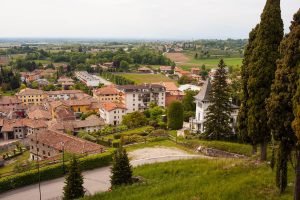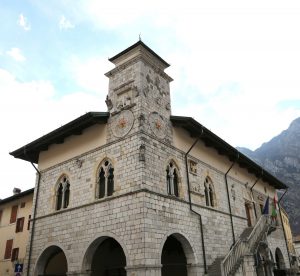The extreme north-east of Italy is one of the newest national territories. Friuli and the remaining part of Venezia Giulia were incorporated comparatively late and retained many a special status. As an autonomous region, it enjoys special rights that preserve, among other things, the Friulian language and culture. In addition, the centuries-long influence of the Republic of Venice and the Austrian-Slovenian borderland can be seen and felt here. Fascinating nature and a wide coastal strip also underline the magical charm of this region, which is also evident in some of the most beautiful places in the country. The private association “I borghi più belli d’Italia” skilfully highlights these, and no less than five of them can be found in the north as well as in the centre of Friuli Venezia Giulia.

©Bigstock.com/bepsimage
Fagagna
Over the centuries, seven ancient hamlets grew together and formed a common village centre, from which Fagagna (approx. 6,000 inhabitants) emerged. Although the first documentary evidence dates back to 983, the roots of the borgo are probably Roman. We walk through Fagagna on old cobblestones, passing all kinds of quiet places and illustrious buildings. Some of them, such as the castle with the patriarchal palace as well as the former castle village, are now only ruins. The other great fortification of the region, the imposing Castello di Villalta, is privately owned and can only be visited from the outside. But even beyond these monumental buildings, one of the most beautiful places in Italy has a lot to offer. In the Cjase Cocèl Museum, a well-preserved farmhouse from the 17th century, you can wonderfully experience the rural life of days long gone. Several palaces, such as the Palazzo della Comunità and Palazzo Pecile, are dedicated to fascinating architecture through the ages. A short tour of the seven local churches more than rounds off your visit.
Poffabro
Poffabro (approx. 200 inhabitants), a district of Frisanco in Val Colvera ever since a Napoleonic decree in 1810, now stands where once a Roman road crossed the Alps. What at first glance appears rather plain and unadorned, unfolds its very own, special aura over time. Poffabro’s rather minimalist architecture with exceedingly rough-cut stone buildings and wooden balconies even survived severe earthquakes. It is precisely this rather sober honesty of the townscape that will enchant you. Exactly the same applies to the Chiesa di San Nicolò Vescovo, which has been renovated and rebuilt many times over the centuries, with its shining white façade – relatively unspectacular and yet captivating. The interior is also modest, with only a 17th century wooden altar and a few wooden sculptures by Giacomo Marizza. The neoclassical sanctuary Beata Vergine della Salute on the outskirts of the village also concentrates on the essentials and underlines the image of a borgo that is in inspiring harmony with its nature.
Sappada Vecchia-Plodn
There are many linguistic enclaves, especially in the Italian north. Sappada Vecchia, the highest-located village in Friuli Venezia Giulia, is also called Plodn in German (approx. 1,340 inhabitants), after the river Piave. Here, people speak a South Bavarian dialect, the so-called Plodarisch or Sappardino, which has a special status even among comparable German linguistic enclaves. The folk culture is also reflected in the appearance of the village, for example in the log architecture. Most of the buildings are made of wood, topped with shingles. Even newer houses rely on this construction method. Numerous old structures lead you through the different parts of the village. In Cottern, for example, you will find s’Krumpm, a house built at the end of the 17th century, while Spanglar’s house in Cima Sappada, at an altitude of 1,300 m above sea level, has also managed to retain its original charm and can even be visited today. The baroque churches are also worth checking out. Elaborate, beautiful ceiling frescoes await you in both the parish church of St. Margherita as well as in the church of St. Oswald.
Toppo
This part of Travesio, also called Tòp or Tuppaz in local dialects, has been divided into two parts since the 13th century. The river Gleria divides Toppo (approx. 400 inhabitants) into a western section around Pino and an eastern section with numerous Masi – building structures partly of medieval origin that roughly correspond to large old farm settlements. In the lush, diverse nature of Toppo, agriculture still plays a rather important role. This is demonstrated by excellent products such as the creamy, salty cheese Val Cosa, which is a must in omelettes from this region. Many of the Masi are furnished with small churches, frescoes and old wells and take you back to days long gone. Your walk through the western and eastern parts will take you to two palaces, that were once built from such farm settlements. The Palazzo dei Conti Toppo was once the result of a merger of several Masi – exactly how many and how many there actually were in total throughout Toppo is unknown today. The magnificent Palazzo Toppo-Wassermann with its 17th century frescoes is certainly worth a visit.

©Bigstock.com/ChiccoDodiFC
Venzone
A devastating earthquake hit large parts of Friuli on 6 May 1976. Together with an aftershock about four months later, large parts of Venzone (approx. 2,200 inhabitants) were destroyed. While the municipality planned on having the village rebuilt with prefabricated building components, a citizens’ committee’s idea eventually prevailed: the rubble was put back together the way it had been before the natural disaster. Thus, you not only experience Venzone as it once was, but also marvel at the will, the diligence and the dedication of a population that simply did not want to give up its home. Large parts of the Duomo di Sant’Andrea Aposolo (Cathedral of St. Andrew the Apostle), construction of which began as early as 1300, could also be reconstructed in this way. The magnificent building with its numerous frescoes and wooden statues is one of the undisputed highlights of the borgo. Historical mummies await you in the Cappella di San Michele, accompanied by Friulian frescoes. The imposing palace on the main square with its loggia and frescoes is now home to the town hall.
Particularly beautiful places await you in the north and in the heart of the region, and they could hardly be more different. Old agricultural structures, block construction, relentlessness, massive fortifications and charming minimalism furnish the beautiful, extremely diverse Friuli Venezia Giulia. The most beautiful places in this region in Italy’s northeast are an experience in their own it, and you can be right in the middle of it all!